This post may contain affiliate links. See my disclosure policy.
With this easy, foolproof recipe and a few simple tips, you’ll be cooking light, fluffy, and aromatic Basmati Rice in no time! Perfect for curries, stir-fries, and more!
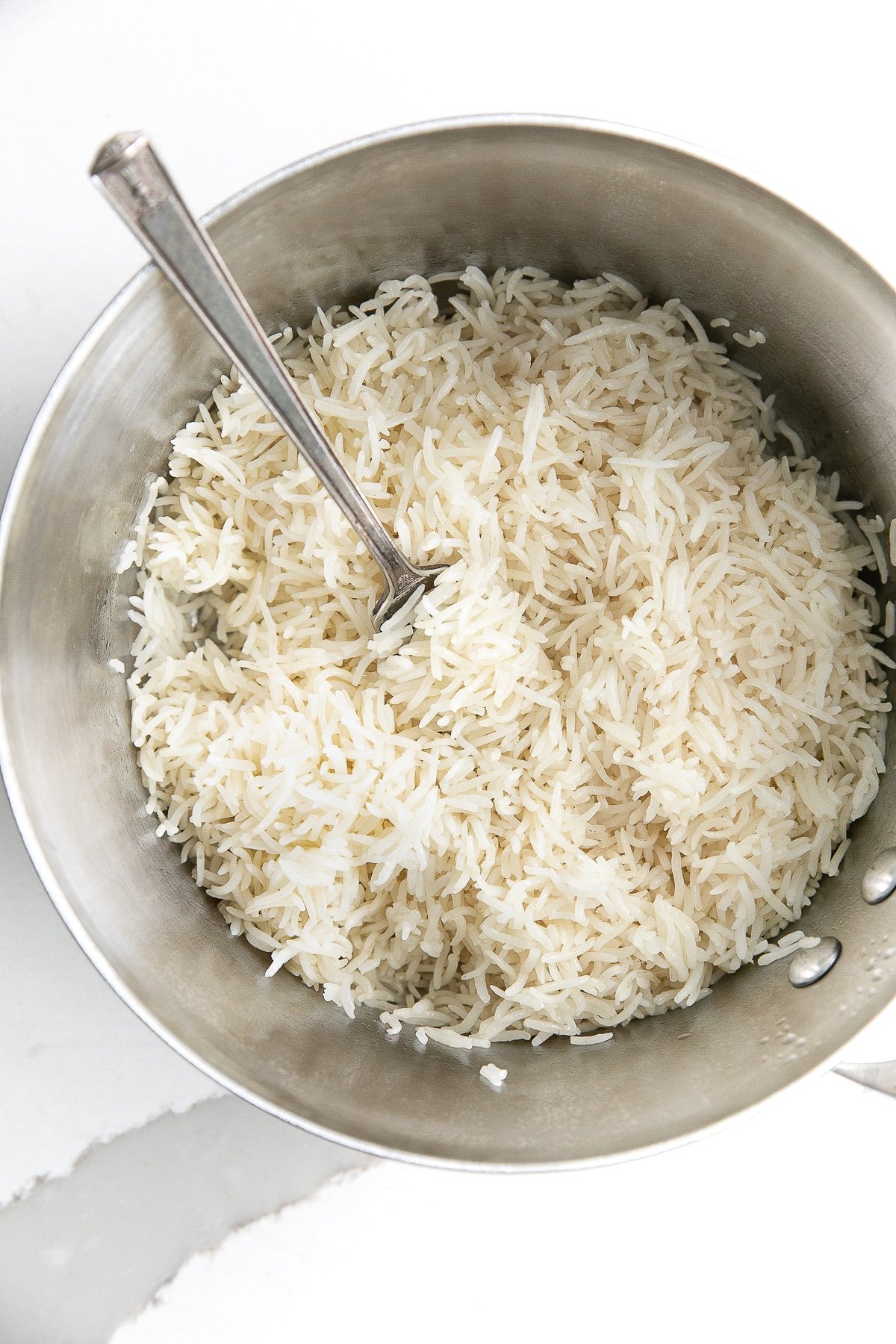
Thanks to my dear mother-in-law, who was born and raised in India, I’ve learned a thing or two about cooking soft and fluffy, restaurant-style basmati rice. Today, I’m sharing her tips (and a few of my own) with you!
Table of Contents
Also, check out how to cook white rice | Jasmine rice | Brown rice | and Wild rice.
Rice to Water Ratio
This seems to be the biggest mistake people make when cooking any type of rice. It’s not your fault. Packaging directions have been misleading us for as long as I’ve been around with the “rule” that rice should be cooked in a 1:2 ratio of rice to water. You guys, this is wrong.
When cooking basmati rice on the stovetop, the correct rice-to-water ratio is 1 cup rice: 1½ cups water.
How to Cook Basmati Rice
This is my go-to method for cooking basmati rice. It’s called the “pilaf absorption method,” which isn’t nearly as complicated as it sounds. Get the full recipe + instructions in the recipe card below.
1. Wash the rice. My mother-in-law will argue that thorough washing isn’t that important since the rice sold here in the US is so clean (compared to the rice she grew up cooking in India). However, I (respectfully) disagree about not needing to wash the rice. Please wash your rice. In at least 2-3 changes of cold water. It helps remove starch from the surface of the grains, resulting in less sticky rice.
2. Drain the rice thoroughly. The rice-to-water ratio is super important since we’re cooking the rice using the pilaf plus absorption method. I like to drain my rice in a fine-mesh strainer, then, if I have enough time, transfer the rice to a clean baking sheet for 5-10 minutes before cooking.
3. Pre-boil your water or stock. I recommend boiling a few tablespoons of additional liquid to account for any loss due to evaporation.
4. Toast the rice for extra flavor. This is the pilaf part of the recipe, where you toast the uncooked rice over medium-high heat in a little bit of olive oil, butter, or ghee and a pinch of salt. This is also a great time to add aromatics like whole cloves, cinnamon stick, whole cardamom, peppercorns, etc.
5. Add the boiling water and cook. Add 1.5 cups of water (or stock) directly to the rice. Return to a boil before decreasing the heat to low and covering it with a tight-fitting lid. Leave the rice to cook for 10-12 minutes without lifting the lid. Tip: If you have a clear glass lid, you can check for doneness by carefully tilting the pan to one side. If you see a pool of extra liquid, you know to keep cooking. If no liquid is visible, it indicates that most of the liquid has been absorbed.
7. Steam. Allow the rice to rest, covered, off heat, and undisturbed, for 10-15 minutes. Just before serving, fluff with a fork and dot with 1-2 tablespoons of butter, if desired.
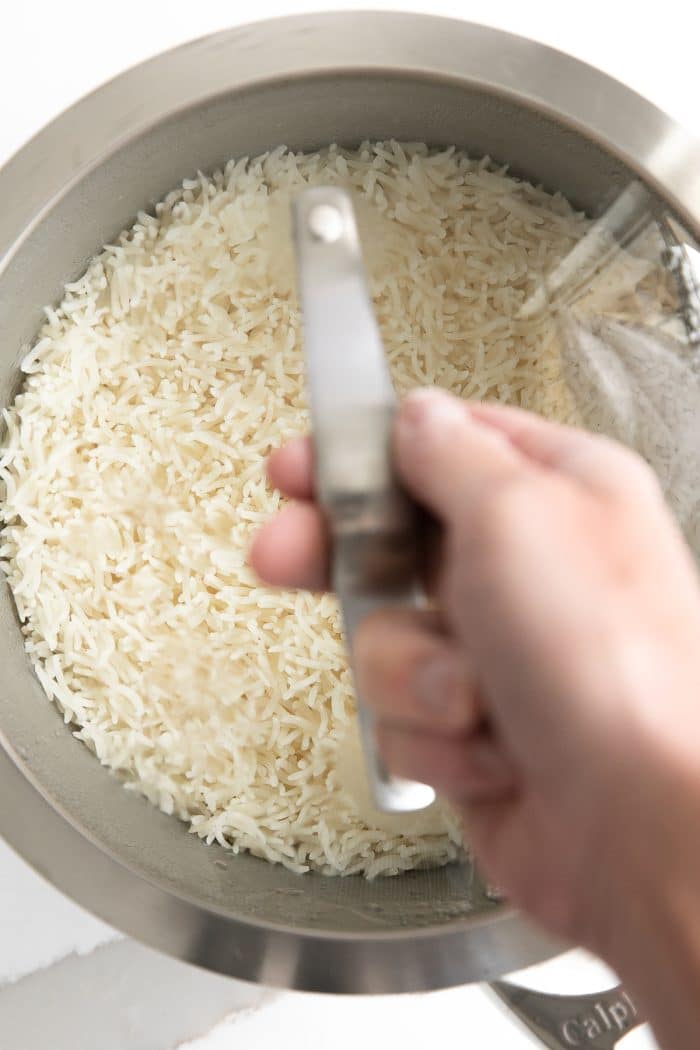
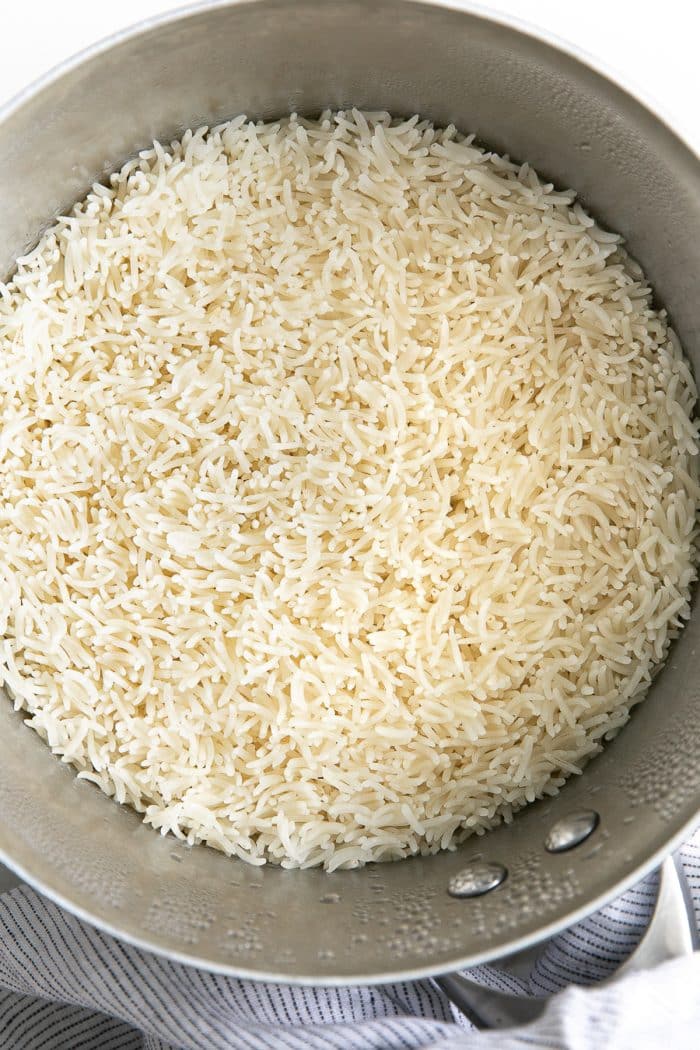
Serving
Basmati rice is incredibly versatile and pairs beautifully with a wide range of dishes thanks to its light, fluffy texture and fragrant aroma. It’s traditionally served alongside Indian curries like chicken tikka masala, butter chicken, Indian dal (red lentils), or vegetable korma, where its mild flavor balances out bold, spicy sauces. It also works well as a base for dishes like kheer (Indian rice pudding), biryani, pilaf (pulao), or tandoori chicken gyros.

For a simple side, toss cooked basmati rice with ghee or butter and fresh herbs like cilantro or parsley. You can also flavor it with whole spices like cumin seeds, cloves, cinnamon sticks, or cardamom.
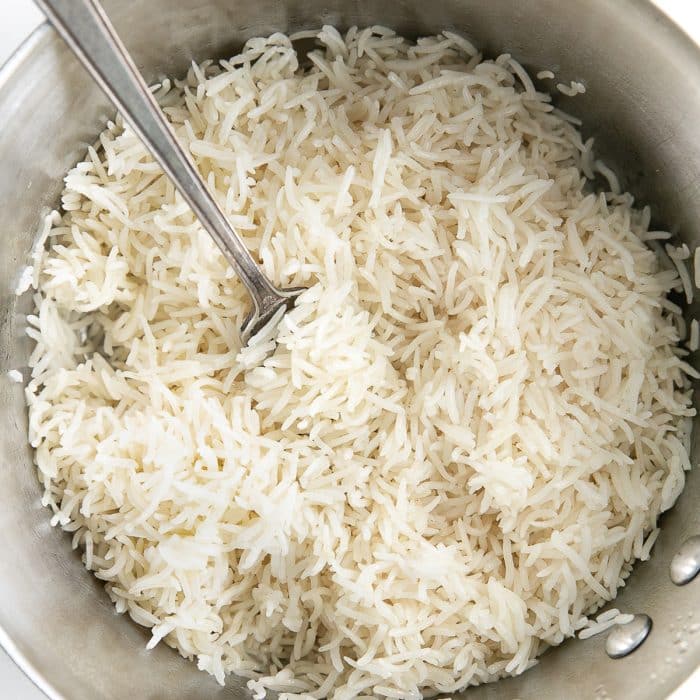
Foolproof Basmati Rice Recipe
Ingredients
- 1 cup basmati rice
- 1½ cups just-boiled water, (or low-sodium chicken stock)
- 2 tablespoon olive oil, (or butter)
- ½ teaspoon salt, plus more to taste
Instructions
- Rinse the rice. Place the basmati rice in a fine-mesh strainer and rinse under cold running water, swishing gently with your hand. Rinse several times, or until the water runs almost clear. This removes excess surface starch and helps the rice cook up fluffy and separate.
- Soak the rice (optional). Transfer the rice to a medium bowl and fill with cold water. Allow rice to soak for 15-20 minutes.
- Drain the rice. After soaking, drain the rice well using a fine-mesh strainer. Shake off as much excess water as possible, then gently tap the strainer on a towel to remove lingering moisture.
- Toast the rice. Heat the olive oil (or butter) in a medium saucepan or wide skillet set over medium heat. Add the rice and salt. Thoroughly mix the rice so that each grain is covered in oil. Toast for 1–2 minutes, just until lightly fragrant.
- Boil the cooking liquid. Bring roughly 1½ cups of water or chicken broth to a boil using a kettle or covered saucepan. Some of the water may evaporate as it comes to a boil; remember to remeasure the liquid before adding it to the rice.
- Cook the rice. Add 1½ cups of just-boiled water (or stock). Increase the heat to high and bring the liquid to a rapid boil. Immediately reduce the heat to low, cover with a lid, and let the rice cook undisturbed for 10–12 minutes. Avoid lifting the lid during this time.
- Tip: If using a glass lid, you can gently tilt the pan to check for excess liquid. If you see water pooling, continue cooking for another minute or two. If the liquid is fully absorbed, it’s ready to rest.
- Rest the rice. Turn off the heat and let the rice sit, covered, for 5-10 minutes to steam. Do not lift the lid. After resting, uncover and gently fluff the rice with a fork. For extra richness, dot with a bit of butter before serving, if desired.
Notes
- One cup of dried basmati rice typically yields about 3 to 3½ cups of cooked rice. To scale up the recipe, use the same water to rice ratio, but be sure to use a larger pot with a wide enough base. Using a pot that is too small will result in rice that is sticky and gummy at the bottom.
- Infuse flavor by adding whole spices like cumin seeds, cloves, cinnamon sticks, or cardamom at the same time that you toast the rice.
- Storage: Cool completely, then transfer leftover rice to an airtight container. Store in the refrigerator for up to 4 days or the freezer for up to 2 months.
Nutrition
Nutrition information is automatically calculated, so should only be used as an approximation.
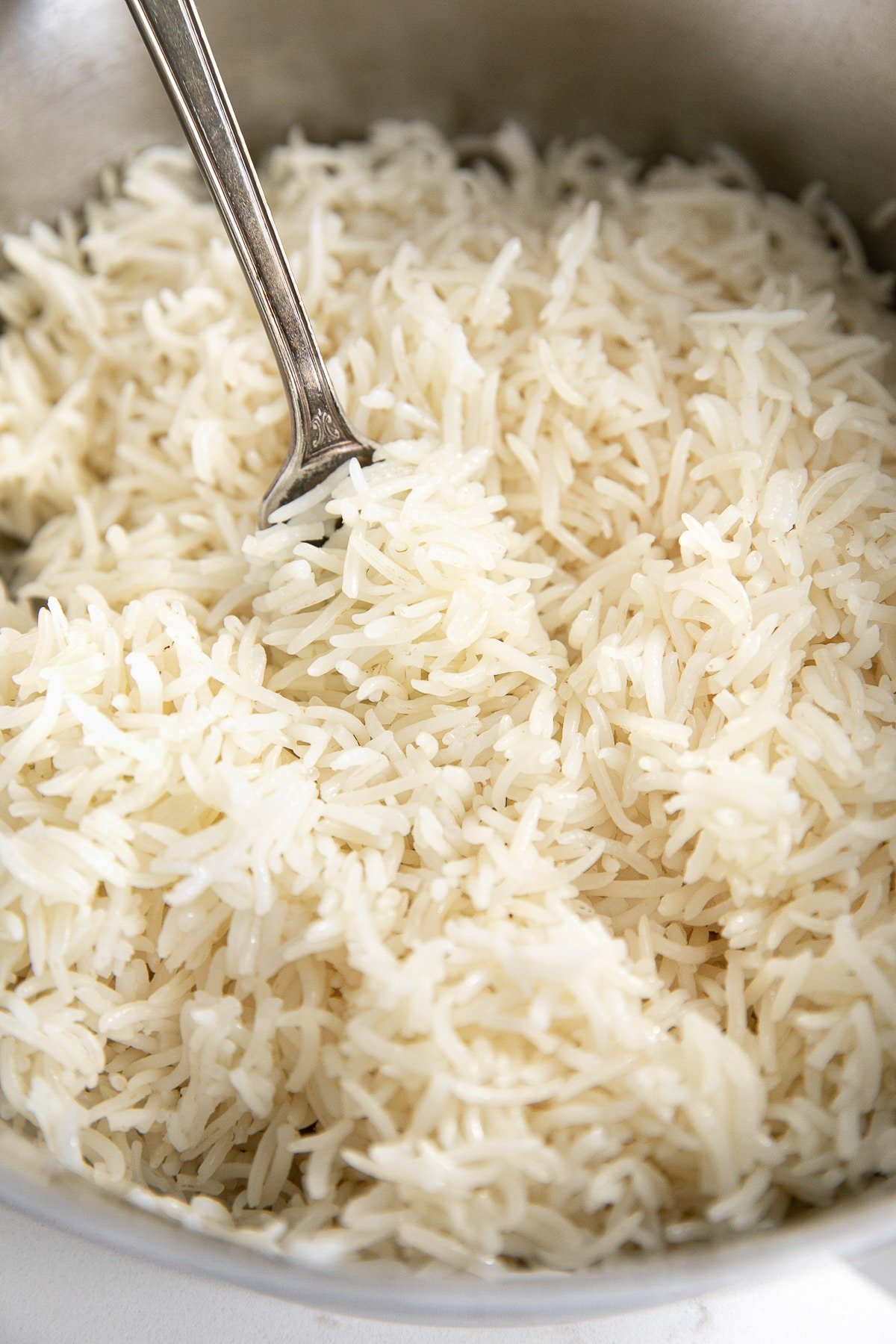
Frequently Asked Questions
Basmati rice is a variety of long-grain, aromatic rice traditionally grown in the foothills of the Himalayas, primarily in India and Pakistan. When cooked properly, basmati rice is light and fluffy – not sticky. It is known for its distinctive fragrance and long, slender grains, making it ideal for recipes like biryani, pilaf, and curry. Check out this post about basmati rice to learn more.
If your rice is mushy or sticky, it usually comes down to a few common issues: too much water, not rinsing the rice, overcooking, or skipping the resting period. Basmati rice requires a specific rice-to-water ratio, 1½ cups of water per 1 cup of rice. Once the water has been absorbed and the rice is tender, it’s important to remove it from the heat and let it sit, covered, for 5 to 10 minutes. This resting period allows steam to redistribute and the grains to firm up. Fluffing too soon or uncovering too early can cause the rice to lose structure and turn clumpy.
Yes, but before doing so it’s important to remember that basmati has a nuttier flavor and aroma compbut before doing so, it’s important to remember that basmati has a nuttier flavor and aroma than neutral-tasting rice, like plain long-grain white rice. This works well in dishes like curries, stir-fries, and pilafs, but for recipes that depend on slightly stickier rice (like casseroles or hearty one-pan rice recipes like jambalaya), it may not be recommended.
Yes, basmati rice freezes very well and is a great meal-prep staple. Begin by spreading the cooked rice on a large baking sheet lined with wax paper. This will cool the rice quickly and prevent bacteria from developing. Next, transfer the cooled rice to a freezer-safe container or zip-top bags. Flatten the bags and remove as much air as possible. Freeze for up to 2 months. You can reheat frozen rice directly in the microwave or in a covered skillet over low heat. Add a splash of water to loosen the grains and remove the frozen rice from the plastic zip top bags before reheating.
Soaking basmati rice isn’t necessary, but it can be beneficial. Soaking for 20–30 minutes in cold water results in longer, fluffier grains, and helps them expand more evenly during cooking. Soaked grains are also less likely to break or clump together. If you’re short on time, rinsing thoroughly in several changes of clean water is the next best thing.
More Delicious Rice Recipes,
This easy Chicken and Wild Rice Soup is made with juicy shredded chicken, tender vegetables, and hearty wild rice simmered in a rich, creamy broth. Includes both stovetop and slow cooker instructions!
This delicious Coconut Rice Recipe comes together with just 5 simple ingredients: jasmine rice, full-fat coconut milk, fresh ginger, and garlic. It’s naturally vegan, gluten-free, and ready in under 30 minutes.
This Stick of Butter Rice is a rich, savory, casserole-style side dish made with just six pantry staples: white rice, butter, French onion soup, beef consommé, onion powder, and garlic powder. It’s easy to make, packed with flavor, and perfect alongside chicken, beef, pork, or fish.
Mango Sticky Rice is one of the most beloved Thai desserts, known for its sweet, creamy, and fruity flavors. Made with steamed glutinous rice, rich coconut cream, and fresh ripe mango, this easy-to-follow recipe shows you how to make authentic khao niaow ma muang right at home.
Arroz Caldo is a warm and comforting Filipino chicken and rice porridge made by simmering glutinous rice in rich, homemade chicken stock until thick and creamy. Flavored with aromatic garlic and ginger, and traditionally topped with toasted garlic, hard-boiled eggs, and scallions, this beloved dish is the ultimate bowl of comfort.
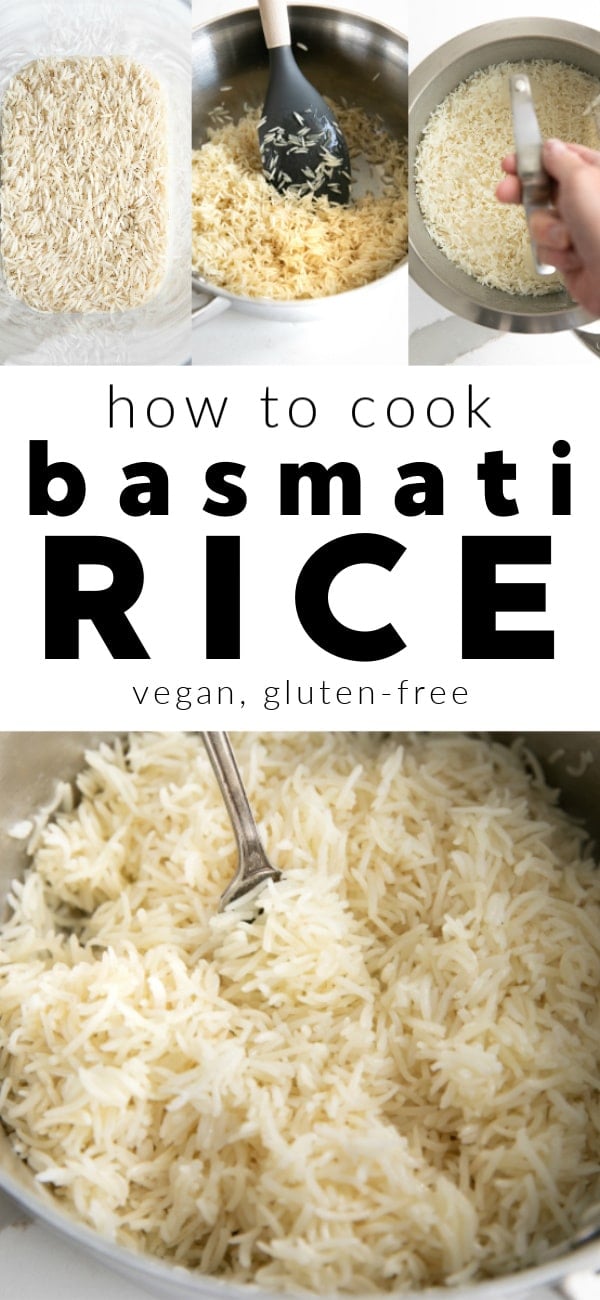
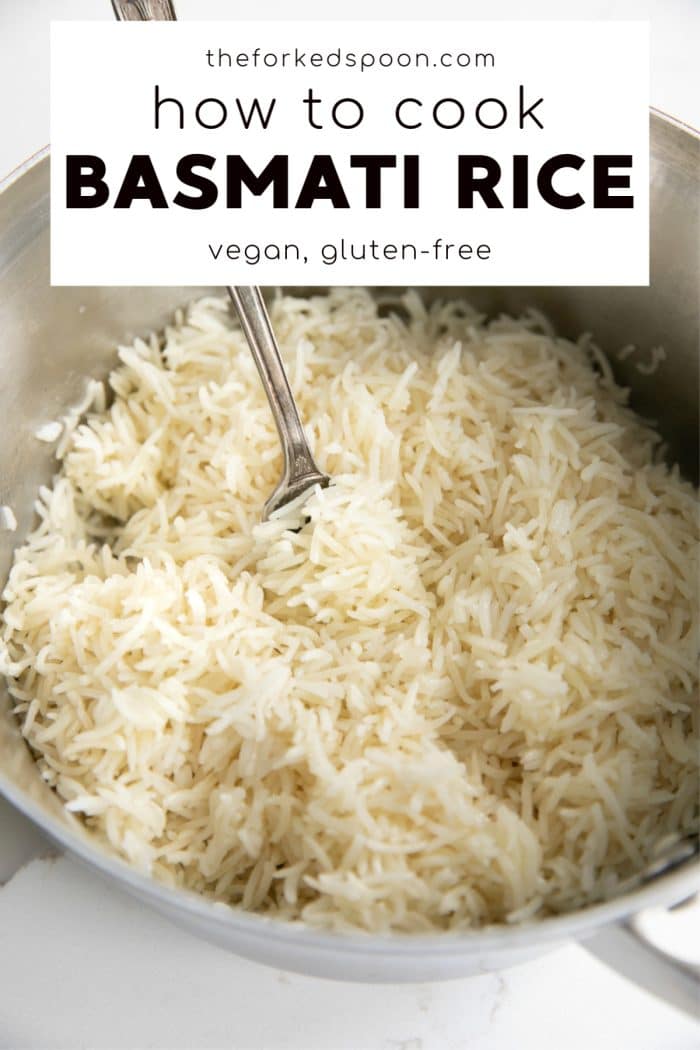
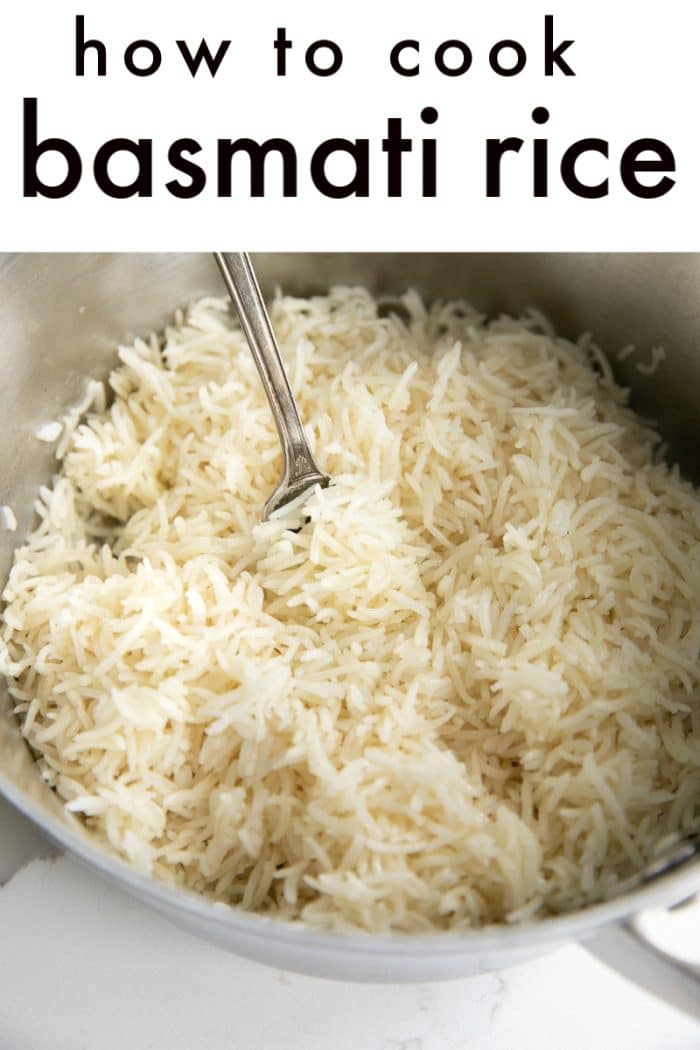


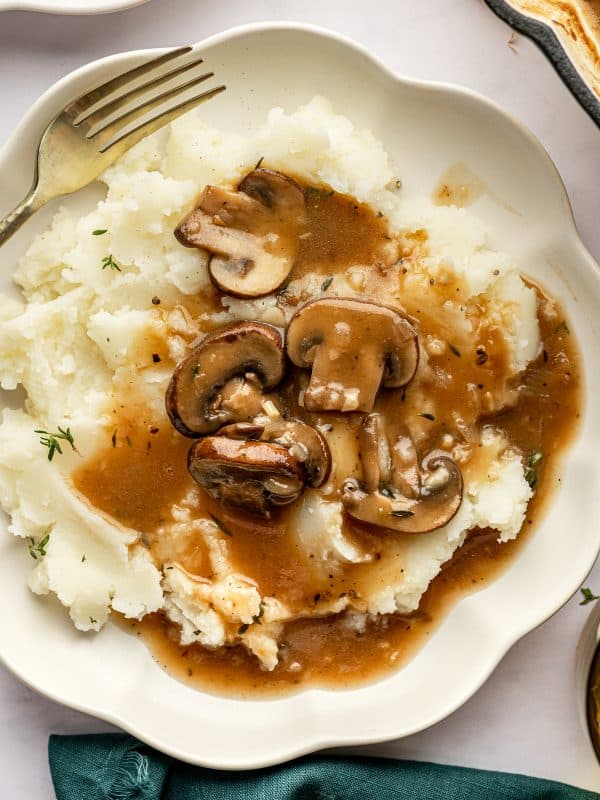
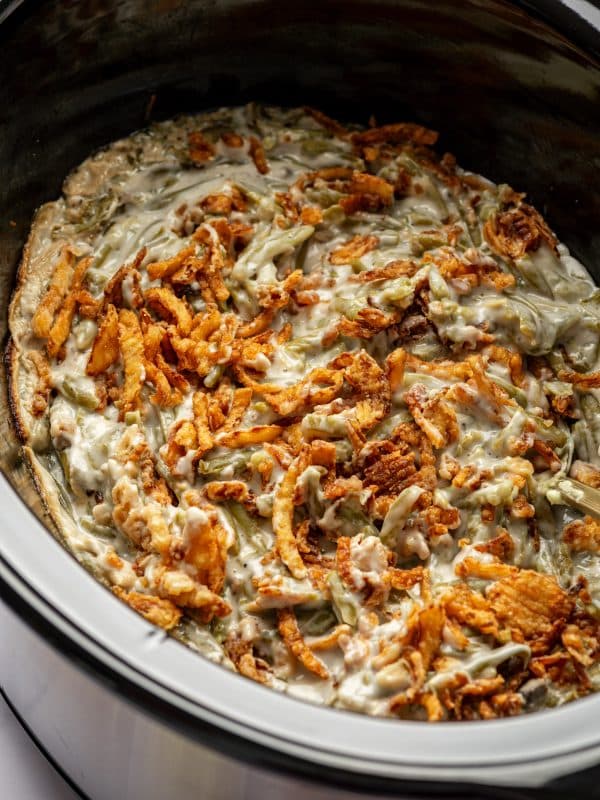
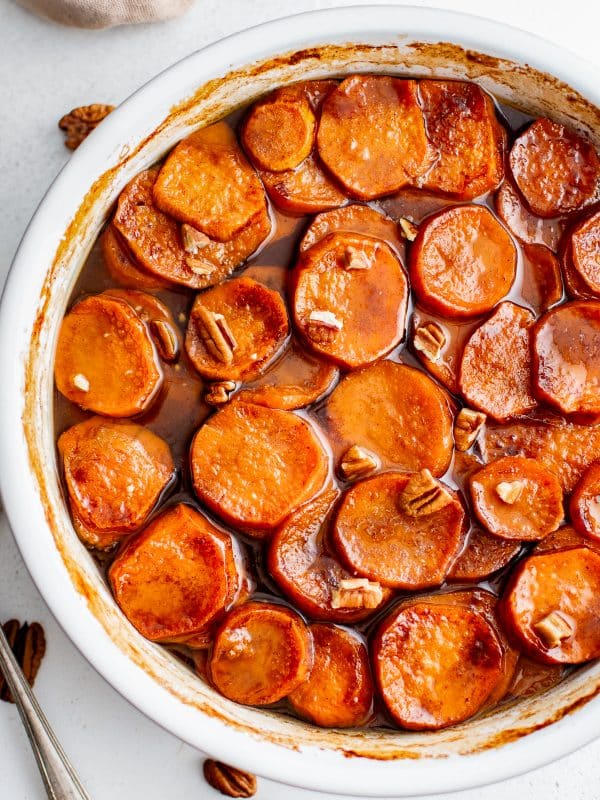
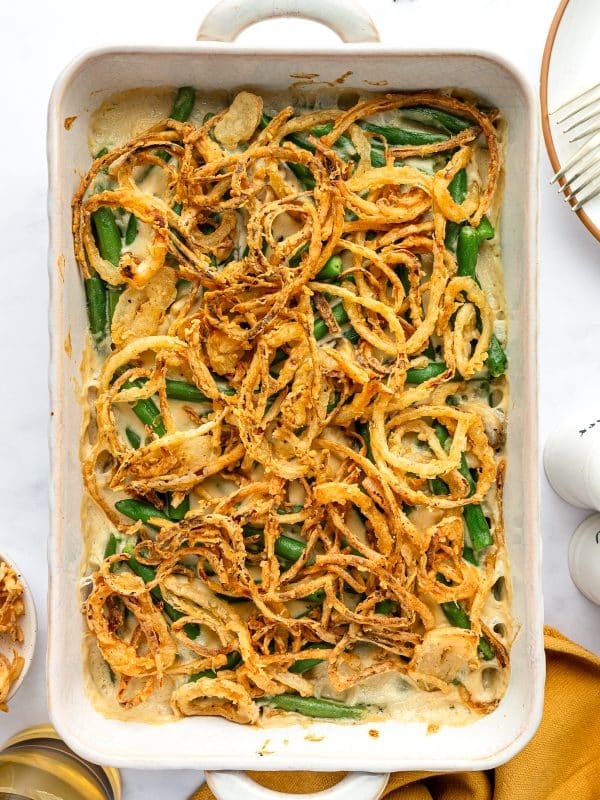








I’ve used this recipe three times now. Changed it up according to what I had on hand.
I dont go through all that trouble of rinsing and washing the rice, I like my rice on the soft side so I put two cups of water for each cup of Royal Basmati rice and heat until the water boils. Then I turn the heat down as far as I can and still keep the water hot but not boiling and put a lid on it with about half an inch open space. I stir the rice once it boils and stir occasionally while it soaks up the hot water. When there is just a little water left at the bottom of the pan I turn the heat completely off, I stir the rice again and put a lid firmly on the pan. After all the water is gone I stir again to keep the grains separate and it is a no fail way to have loose grain white Basmati Rice.
When I have time I will toast the rice in a dry pan until they turn a light brown for that added aroma and taste.
Hi Jessica
I’m wanting to switch to Basmati rice from the Asian jasmine rice. There are many types of Basmati rice in the market. Can you please recommend a white Basmati rice similar to the one they use for Biryani.
Thank you very much.
North Indian Biryani uses a white long-grain rice.
This is an excellent recipe! I followed every instruction & rice came out the best I’ve ever made it.
Thanks, Janet, I really appreciate your excellent feedback 🙂
Thanks for this basic recipe. It worked well.
Thanks for the kind feedback Renee 🙂